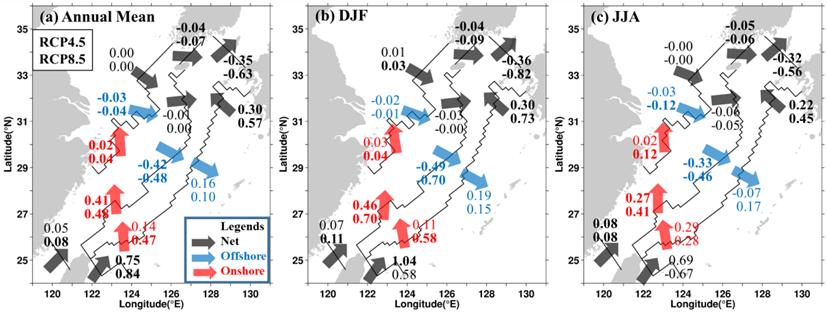Led by Prof. Dongliang Yuan of Institute of Oceanology, Chinese Academy of Sciences (IOCAS), a joint research team composed of scientists from China and Germany, has recently evaluated the long-term projections of the cross-shelf transports in the East China Sea under greenhouse warming, suggesting their potential importance for “cross-shelf carbon burial”. A related paper has recently been published in “Climate Dynamics”, which is an academic journal of international climatology research.
The cross-shelf exchange between the eastern China seas and the Kuroshio is of great significance for vorticity, freshwater, and effluence balances of the regional and global oceans. In winter, the East China Sea Current moves from the mouth of the Old Huanghe (a.k.a. the Yellow River) to the shelf edge, accompanied by subduction of cold shelf water into the Kuroshio subsurface waters about 100-200 m deep, which enters the global ocean circulation in the subthermocline. The re-surfacing of these waters and the associated dissolved carbon shall take as long as 100 years or so. The structures and dynamics of this cross-shelf circulation system are identified first by Prof. Dongliang Yuan and his collaborators.
Associated with the subduction of the shelf waters, the carbon-enriched shelf water is transferred into the subsurface ocean and is shielded from participating in the global warming processes. This type of cross-shelf subduction represents a carbon sink to the deep ocean, named as the “cross-shelf carbon burial” (Yuan et al., 2018), which is one of the largest marine carbon sequestrations in the eastern China seas. Climatically, the net volume transport across the 100 m isobath is estimated at about 1.1 Sv (about 100 times of the Yangtze River discharge). The offshore component is usually an order of magnitude higher, which plays an important role in the transportation of terrestrial and shelf materials to the open ocean. However, the long-term changes of the cross-shelf transports under global warming scenarios have not been investigated.
Recently, the responses of the cross-shelf transports to future climate changes are estimated based on a regionally zoomed global coupled model (Hao et al., 2021). The results have shown that the cross-shelf transports are projected to increase significantly from 2006 to 2099 (Fig. 1). The maximum increase is found in winter, with the rate of increase to be as large as 20%, showing potential importance in carbon transportation and storage. Analyses suggest that the winter monsoon has a long-term southwesterly increment, forcing coastal currents to flow into the Yellow Sea along the China coasts, which compensate for the increase of the southeastward surface Ekman transport. In the meantime, increases of the Tsushima Strait and upper-layer Kuroshio transports also attribute to the enhancement of the cross-shelf transports.
This work was supported by the National Natural Science Foundation of China, the National Key Research and Development Program of China, and the Strategic Priority Research Program of Chinese Academy of Sciences. The results will provide scientific evidence for increasing carbon sink to support the surrounding countries in achieving carbon neutrality.

Fig. 1. Schematic of the long-term changes (Sv) of the cross-shelf transport from 2006 to 2099.
Reference:
Hao Jiajia, Yuan Dongliang, Tian Di, Su Jian, Phlmann Thomas. Long-term changes of cross-shelf transports in the Yellow and East China Seas under different greenhouse gases emission scenarios. Climate Dynamics, 2021. https://doi.org/10.1007/s00382-021-06045-8.
Yuan Dongliang, Hao Jiajia, Cross-shelf carbon transport under different greenhouse gas emission scenarios in the East China Sea during winter. Science China-Earth Sciences, 2018, 61(6):659-667. doi:10.1007/s11430-017-9164-9.
(Editor: ZHANG Yiyi)
|
|

Address: 7 Nanhai Road, Qingdao, Shandong 266071, China
Tel: 86-532-82898902 Fax: 86-532-82898612 E-mail: iocas@qdio.ac.cn


